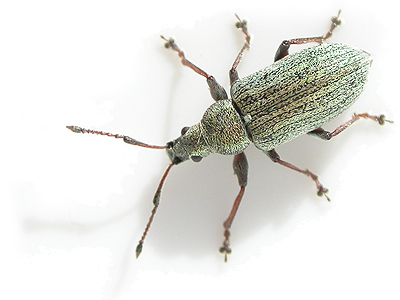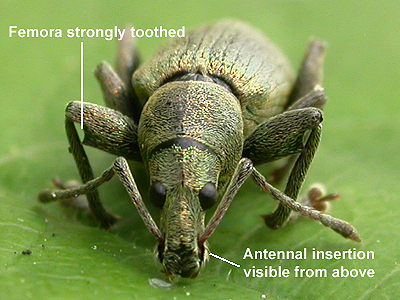

| Phyllobius Weevils in Nottinghamshire | ||
| Conspicuous through their bright
green colouration, Phyllobius Weevils are often
readily obvious to someone with little interest in
Coleoptera. Several species are common and easily found
on low growing plants in a variety of situations, but
identification to species level can often be quite
difficult. This page is not designed with accurate identification in mind, but purely to illustrate some of the Phyllobius Weevils found in Nottinghamshire and to make brief comparisons with Polydrusus Weevils, some of which are also green and can create confusion. Any identification points made, will be readily visible under a small hand lens. Phyllobius and Polydrusus Weevils (Curculionidae) both feed on the foliage of various plants. The commonest species is P. pomaceus, which is sometimes known as the Green Nettle Weevil. |
 |
|
| .............. | ||
| However, as with many common names, it is slightly misleading from the point that there are other species which are just as frequently found on Nettles. Although usually to be encountered on Nettles, the large (around 10mm) P. pomaceus is just as likely to occur on most other low vegetation types, but in our own experience, it is rarely found on foliage above head height. When beating or sweep netting the lower branches of trees, the commonest of the green weevils at Sherwood Forest are P. pyri and the much smaller P. roboretanus. | ||
| .............. | |||||
| Separation of Phyllobius from green Polydrusus Weevils | |||||
| .............. | |||||
|
Separating green Phyllobius
and Polydrusus Weevils is by the position of the
antennal insertion on the head. This is easily achieved
in the field with a small hand lens. Comparison between
the two is shown in the photographs on the left, with Phyllobius
on the far left. In all Phyllobius sp, the insertion point is viewable from above, whilst not visible from above in Polydrusus sp. |
||||
| .............. | |||||
| Before proceding further,
it is worth pointing out that not all Phyllobius Weevils
are green. Indeed, P. pyri is most easily
recognised by it's lack of green colouration and P.
oblongus (not known from Sherwood) is chestnut
brown. Although extremely variable, P. pyri very
rarely shows any amount of the metallic green scaling of
most other Phyllobius weevils. As with all Phyllobius weevils, the bright green colouration comes from a covering of dense scales, which are easily rubbed off. Through age, adults can become devoid of virtually all green scaling and generally appear black or very dark brown (especially on the legs) Identification then becomes less straight forward and more reliant on structural differences. To confuse matters even further, a rare Sherwood Phyllobius (P. viridicollis) loses most of it's scales almost immediately upon hatching, but this species has not been recorded at Sherwood for about a century. |
 |
|
| .............. | ||
|
For those who may wish to
determine a specimen a little further, then a key
identification feature of Phyllobius weevils, is
the presence of a prominent tooth on the underside of the
femora. This is shown in the photograph of P.
pomaceus on the right. The femoral tooth is often visible (through resting posture) under a hand lens if the beetle is viewed from above. The table on the left shows those Phyllobius Weevils with toothed femora and those without. |
||||||||||||||||||||||
| .............. | |||||||||||||||||||||||
| Phyllobius
Weevils in Nottinghamshire There are a total of ten species of Phyllobius known from the UK. Nottinghamshire is well represented with nine of these which include Phyllobius argentatus, P. glaucus, P. maculicornis, P. oblongus, P. pomaceus, P. pyri, P. roboretanus, P. virideaeris and P. viridicollis. Seven species are currently known from the Sherwood Forest NNR. |
|||||||||||||||||||||||